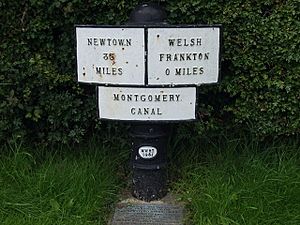Frankton Junction facts for kids
Quick facts for kids Frankton Junction |
|
|---|---|

The route to Hurleston Junction passes through the bridge. Llangollen is to the left, and the Montgomery Canal to the right.
|
|
| Specifications | |
| Status | Open |
| Navigation authority | Canal & River Trust |
| History | |
| Date completed | 1806 |
| Date closed | 1936 |
| Date restored | 1987 |
Frankton Junction is a special place where two canals meet. It's located in Lower Frankton, Shropshire, England. Here, the Montgomery Canal ends and joins the Llangollen Canal. Think of it like a crossroads for boats!
History of the Canals
The Llangollen Canal wasn't always called that. It was first part of a bigger project called the Ellesmere Canal. Building this canal was approved by a special law from Parliament in 1793. By 1796, parts of it were already open. One section went from Chester to Ellesmere Port. Another important part was the Llanymynech Branch. This branch started at Hurleston Junction and went through towns like Whitchurch and Ellesmere, reaching Frankton and then Llanymynech.
About ten years later, a lot more canal had been built. This included a special channel from Frankton to Llangollen. This channel brought water from the River Dee. This water was super important! It supplied most of the canal network. When this channel was finished, it created the Frankton Junction we know today.
Over the years, the canals changed owners and names many times. First, the Ellesmere and Chester Canal companies joined together in 1813. Later, in 1845, this company joined with the Birmingham and Liverpool Junction Canal. This canal connected Nantwich to Autherley Junction near Wolverhampton. The next year, the company changed its name again to the Shropshire Union Railways and Canal Company. Soon after, it became part of a big railway company called the London and North Western Railway.
The Montgomeryshire Canal also got approval in 1793. But it was meant to be a separate canal. It ran south from Carreghofa to Newtown. The first part opened in 1797. However, they ran out of money. The canal wasn't finished all the way to Newtown until 1821. This last part was even built by a third company! The Montgomery Canal never made much money. Its different sections eventually became part of the Shropshire Union network in 1847 and 1850.
Boating on the Montgomery Canal became very quiet in the 1920s. The junction basically closed in 1936. This happened because a part of the canal broke near Perry Aqueduct. This spot was about one mile south of the junction. In 1944, many miles of the Shropshire Union network were officially closed. But the main part of the Shropshire Union Canal stayed open. The branch to Llangollen, which goes through Frankton Junction, also stayed open. This was because it was still needed to supply water.
Restoring the Canals
People started wanting to bring old canals back to life. So, in 1969, work began on what was then called the Montgomery Arm. This happened because a new road threatened to fill in the canal bed in Welshpool. Soon after, the whole branch became known as the Montgomery Canal.
Hopes for restoring the canal grew in 1986. British Waterways asked Parliament for permission to rebuild the canal. Montgomeryshire County Council promised £1 million to help pay for repairs. This money would be given over five years. The special law was passed in late 1987. But even before that, the Frankton Locks were reopened on September 12th. These locks are just south of the junction.
Prince Charles spoke at the reopening event. He mentioned that volunteers had worked 12,000 hours to fix the locks. This work was worth about £200,000! With the locks open again, the junction was back in use.
Location and Features
Frankton Junction is in Lower Frankton. However, signs along the Montgomery Canal show distances to Welsh Frankton. This is the next village nearby.
The Llangollen Canal has two bridges near the junction. Peter's Bridge is to the east. Rowson's Bridge is to the west. At Rowson's Bridge, the path for walking (called a towpath) crosses from one side of the canal to the other.
Right after the junction, going south on the Montgomery Canal, you'll find the Frankton Locks. These are a series of two locks that go down like stairs, plus two single locks. A little further along the canal is a fifth lock. It's named after Graham Palmer. He started the Waterway Recovery Group, which helped a lot with rebuilding the canal. This lock is quite small. It was added to make up for changes in the ground level since the canal closed in 1936.
From the junction, the canal is flat towards Llangollen for about 3.4 miles. Then you reach the first of the New Marton Locks. Going the other way, the canal is also flat through Ellesmere Tunnel. It passes the Ellesmere Arm, the Prees Branch, and the Whitchurch Arm. After that, you reach the top lock of six at Grindley Brook. This is about 16.5 miles from the junction.
Bridge Numbers
The bridges along the Llangollen Canal near Frankton Junction have interesting numbers. This is because of how the canals were built and renamed. The bridge to the east is number 69 (Peter's Bridge). The bridge to the west of the junction (Rowson's Bridge) is called both 70 and 1. As you go further west towards Llangollen, the bridge numbers continue as 2, 3, and so on. Bridge number 71 (Lockgate Bridge) is actually on the Montgomery Canal. The Montgomery Canal uses its own numbering system, starting with 71. This means the Llangollen Canal has two different sets of bridge numbers that meet at Frankton Junction!


